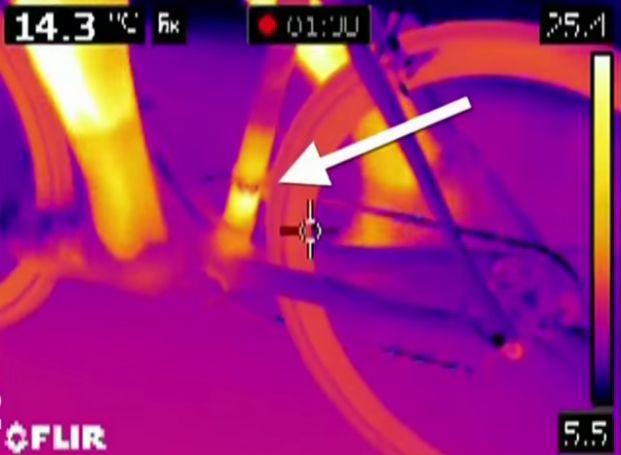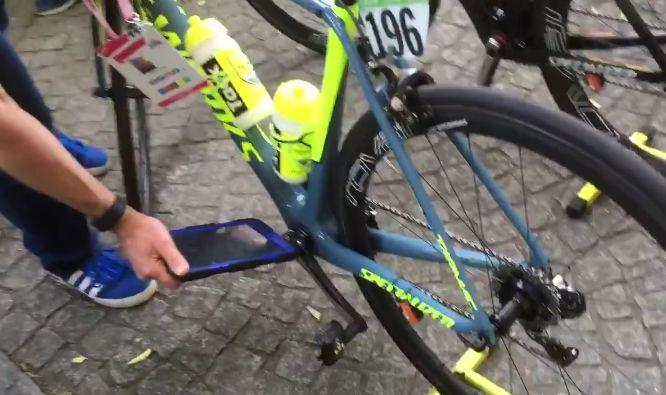- News
- Reviews
- Bikes
- Components
- Bar tape & grips
- Bottom brackets
- Brake & gear cables
- Brake & STI levers
- Brake pads & spares
- Brakes
- Cassettes & freewheels
- Chains
- Chainsets & chainrings
- Derailleurs - front
- Derailleurs - rear
- Forks
- Gear levers & shifters
- Groupsets
- Handlebars & extensions
- Headsets
- Hubs
- Inner tubes
- Pedals
- Quick releases & skewers
- Saddles
- Seatposts
- Stems
- Wheels
- Tyres
- Tubeless valves
- Accessories
- Accessories - misc
- Computer mounts
- Bags
- Bar ends
- Bike bags & cases
- Bottle cages
- Bottles
- Cameras
- Car racks
- Child seats
- Computers
- Glasses
- GPS units
- Helmets
- Lights - front
- Lights - rear
- Lights - sets
- Locks
- Mirrors
- Mudguards
- Racks
- Pumps & CO2 inflators
- Puncture kits
- Reflectives
- Smart watches
- Stands and racks
- Trailers
- Clothing
- Health, fitness and nutrition
- Tools and workshop
- Miscellaneous
- Buyers Guides
- Features
- Forum
- Recommends
- Podcast
TECH NEWS
 Motor hidden in bike frame (Stade 2 video image, April 2016).JPG
Motor hidden in bike frame (Stade 2 video image, April 2016).JPGUpdated: X-ray trucks to detect motors in Classics and Grand Tours
The UCI, cycle sport’s world governing body, has today announced that it will use X-ray equipped trucks to check bikes for motor assistance at this year’s Grand Tours and five of the biggest one-day races, and will randomly select bikes to dismantle following stages/races.
Any bikes deemed to be suspicious will also be dismantled, and officials will continue scanning bikes with tablet devices.
UCI president David Lappartient has made targeting technological fraud a major priority. Back in December he said that it would be a “disaster for the sport” if a leading rider were caught using a concealed motor.

The UCI has previously used tablet devices to scan bikes, and thermal imaging cameras were used in the 2016 and 2017 editions of the Tour de France to try to detect any concealed motors.
Belgian cyclo-cross rider Femke Van den Driessche was banned from cycling for six years following the discovery of a concealed motor in a bike prepared for her at the world championships in Zolder at the end of January 2016.
The UCI appointed Jean-Christophe Péraud, runner-up to Vincenzo Nibali in the 2014 Tour de France, as its manager of equipment and the fight against technological fraud in November last year.
“As well as the Grand Tours, the races affected by the new UCI measures are the Milan-San Remo, the Tour of Flanders, Paris-Roubaix, Liege-Bastogne-Liege and the Tour of Lombardy,” reports Reuters.
The 2018 Milan-San Remo was raced last Saturday, Vincenzo Nibali taking the win.
There are currently very few details about the UCI's new plans, other than that X-ray equipped trucks will feature, although the UCI has announced a news conference to be held today where measures will be outlined in more depth.
Mat has been in cycling media since 1996, on titles including BikeRadar, Total Bike, Total Mountain Bike, What Mountain Bike and Mountain Biking UK, and he has been editor of 220 Triathlon and Cycling Plus. Mat has been road.cc technical editor for over a decade, testing bikes, fettling the latest kit, and trying out the most up-to-the-minute clothing. He has won his category in Ironman UK 70.3 and finished on the podium in both marathons he has run. Mat is a Cambridge graduate who did a post-grad in magazine journalism, and he is a winner of the Cycling Media Award for Specialist Online Writer. Now over 50, he's riding road and gravel bikes most days for fun and fitness rather than training for competitions.
Latest Comments
- rookybiker 46 min 30 sec ago
The trailer seems to connect to both ends of the rear axle. Can it do tight corners without dragging the tyre sideways?
- mattsccm 46 min 37 sec ago
Surely the answer is to ban urban traffic. This cobblers about wide vehicles squeezing down between two sets of parked cars would be easy to solve...
- froze 49 min 50 sec ago
Motorists have always been unkind to cyclists, but distracted driving is adding to the problem....
- Destroyer666 1 hour 43 min ago
Have you owned Bont shoes? In my experience even the widest Lake shoes have had a bizarre form of narrowing way too much in the toe area. But the...
- froze 2 hours 10 min ago
Not sure if this is possible, but this news letter goes out all over the world, and some places like Decathlon does not send stuff to America, in...
- Hirsute 2 hours 55 min ago
I'm confused as to why you'd need bib shorts indoors.
- Oldfatgit 3 hours 24 min ago
I'm sure you were being sarcastic... however ... Lewis Hamilton lives in Monaco. Yet another car driver that doesn't pay any tax
- BikingBud 5 hours 36 min ago
Paddington Harrow Road crash leaves two seriously injured...
- TheBillder 9 hours 2 min ago
I've had (past tense is deliberate) 3 of these over the past 5 years. I'm back here researching for a replacement as my last one broke last week. I...
Add new comment
8 comments
Wonder what the fuel efficiency is for a lead lined truck???
£400,000 for an x-ray truck. I wonder if it was bought with donations from certain teams on the WorldTour...
Unless they're mad, they'll be paying much smaller sums for a service, not buying it.
This could actually work, if done right. I'm a bit sceptical about the tablet detection as it's possible to make motors with no permanent magnets, albeit not quite as efficient as those with magnets.
When I first heard about this, I couldn't help imagining Wile E. Coyote, bursting out of the side of a truck astride a giant horseshoe magnet with "Acme Motor Detectors" stencilled on the side of it, flying through the air in pursuit of a passing TGV.
White elephant come to mind
This will be a roaring success simply because no pro tour team could even think of trying electric motors.
Surely just weighing the bikes would be a good start point?
If the UCI minimum weight is 6.8kg and the lightest motor I can see online coming out at 1.8kg including battery (Vivax Assist), then (allowing for replacing any lead ballast in sub-6.8kg bikes and using a cut-down battery) any bikes approaching 8kg and over would be suspicious?
Yeah but it's likely that they would use a much lighter bespoke or non widely available solution anyway, plus bikes can be made very light these days